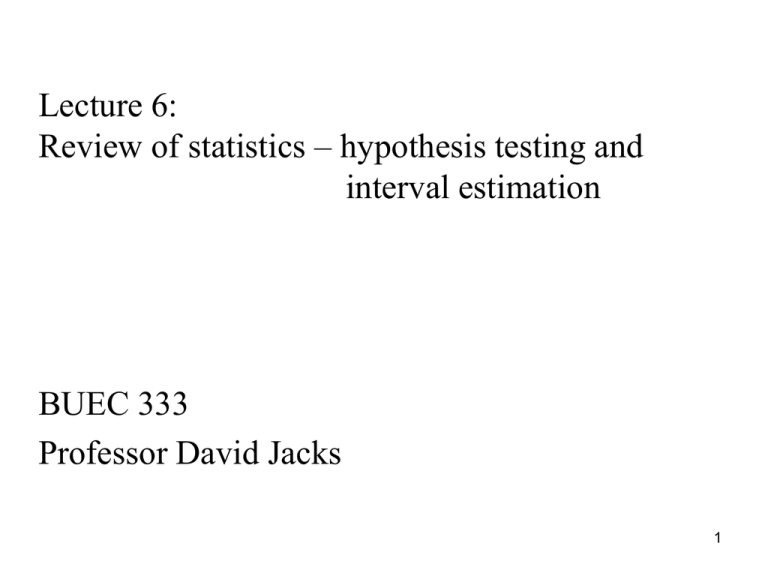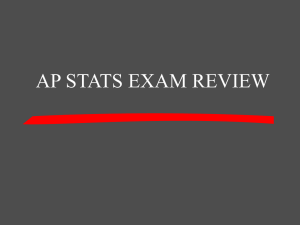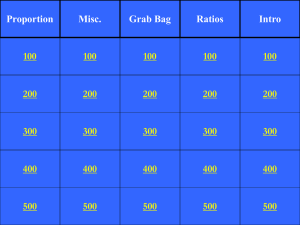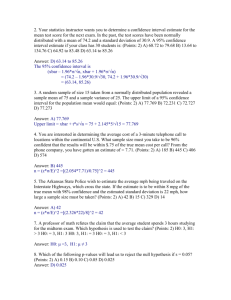Lecture 6: Review of statistics – hypothesis testing and interval estimation
advertisement

Lecture 6: Review of statistics – hypothesis testing and interval estimation BUEC 333 Professor David Jacks 1 Again, we care about sampling distributions as they are fundamental to hypothesis testing. Our goal is almost always to learn about the population distribution. Knowing the sampling distribution of our sample estimator (e.g., the sample mean) gives us a way to assess whether particular values of population quantities (e.g., the population mean) are likely. The importance of sampling distributions 2 An essential component of hypothesis testing makes use of our knowledge of probability distributions. Generally, this involves figuring how far away a particular observation (or statistic) is from its expected (or hypothesized) value. A convenient way of expressing this idea is in terms of how many standard deviations an The use of probability distributions 3 A woman posted on a blog that she had been pregnant for 310 days (about 10.20 months) before giving birth. Completed pregnancies are normally distributed with a mean of 266 days and a standard deviation of 16 days. If we subtract the mean from 310 and divide by the standard deviation, this tells us how many A “normal” example 4 0.20 0.15 0.10 0.05 0.00 200 z 222 x 244 266 288 310 -4 -3 -2 -1 0 1 2 3 4 310 266 16 Thus, it seems this women’s experience was a very rare one… A “normal” example 5 Likewise, we use hypothesis tests to evaluate claims like μ = 6 or σ2 = 16. Given the sampling distribution of a sample statistic, we evaluate whether its observed value in the sample is likely when the above claim is true. We formalize this with two hypotheses. For now, we focus on hypotheses with respect to the population mean, but this approach can be Hypothesis testing 6 Suppose we are interested in evaluation a specific claim about the population mean. For instance: a.) “the population mean is 6” b.) “the population mean is positive” The claim to be evaluated is the null hypothesis: a.) H0 : μ = 6 b.) H0 : μ > 0 We compare it to the alternative hypothesis: a.) H1 : μ ≠ 6 (a “two-sided” alternative) Null and alternative hypotheses 7 Step 1: Specify the null and its alternative. Step 2: Compute the sample mean and variance. Step 3: Use the estimates to construct a new statistic (“a test statistic”) that has a known sampling distribution when the null hypothesis is true (“under the null”). Note: the sampling distribution of the test statistic will depend on the sampling distribution How tests about the population mean work 8 Step 4: Evaluate whether the calculated value of the test statistic is “likely” when the null hypothesis is true. We reject the null hypothesis if the value of the test statistic is “unlikely”. We do not reject the null hypothesis if the value of the test statistic is “likely”. How tests about the population mean work 9 Suppose we have a random sample of n observations from a N(μ, σ2) distribution. And we want to test the null against the alternative hypothesis: H0 : μ = μ0 versus H1 : μ ≠ μ0. Good place to start: the sample mean, X-bar; if the null is true, then the sampling distribution of X-bar is normal with mean μ0 and variance σ2/n. Example: the t-test 10 Because X ~ N(μ0, σ2/n) under the null, we know If we knew σ2 and computed Z, this would be our test statistic: if Z is “close to” zero, it is likely that the null hypothesis is true, and we would not reject it (the same for “far from”/unlikely/would reject). Problems with this approach: first, we do not know σ2; furthermore, how to quantify “close to”? Example: the t-test 11 General rule: Don’t know it? Estimate it! It can be shown that Note that this test statistic has two key properties: 1.) it does not contain any unknowns so we can compute it. 2.) we know its sampling distribution so we can use tables to see if a particular value is “likely” or not under the null. Example: the t-test 12 1.) Form the null and alternative hypotheses. 2.) Use the sample data to construct a test statistic that has a known sampling distribution when the null hypothesis is true. 3.) Decide whether to reject the null or not when the value of the test statistic that we observe is “likely” or not under the null. This is how we do it (i.e. all hypothesis testing) 13 By knowing the sampling distribution of the test statistic, we know the probability that the value of the test statistic will fall in a given interval when the null is true. Corresponds to the area under the pdf of the test statistic’s sampling distribution. And if T is our test statistic, for any α we can find L, U Particular values of the test statistic—likely or not? s 14 We can define a range of “acceptable” values of the test statistic: let [L,U] be an interval such that if the null is true, the test statistic falls in the interval with probability 0.95 (or α=0.05). If null is true and we draw 100 random samples, the test statistic will fall in this interval 95 times; if value of test statistic outside this interval, it is “unlikely” that the null is true Particular values of the test statistic—likely or not? 15 When testing a hypothesis, always the possibility that we make one of two kinds of errors: 1.) Type I: erroneously reject the null when true. 2.) Type II: fail to reject the null when false. Denote the probability of making a Type I error, α, and call α the significance level of the test. Denote the probability of making a Type II error, β, and call (1–β) No one is perfect: Type I and II errors 16 We usually choose a significance level α that sounds appropriate (say, 0.05 or 0.10) and look for a powerful test (small β). But as with so many things, nothing comes for free: there is a tradeoff between the two. As α gets smaller, β must get bigger. Example from the courtroom: No one is perfect: Type I and II errors 17 No one is perfect: Type I and II errors 18 Survey of 121 randomly selected Canadians about the # of times they went to the movies last year. Using survey data, we calculate X 7.5, s 2 75 . Test the hypothesis that the population mean of movie attendance is 9: H0 : μ = 9 versus H1 : μ ≠ 9. Assume that movie attendance is probably normally distributed in the population and construct the T statistic: An example 19 Know that T ~ tn-1 = t120 if H0 is true. For the t120 distribution at the 10% level of significance (α = 0.10), the critical value is 1.658. For the t120 distribution at the 5% level of significance (α = 0.05), the critical value is 1.980. This means that if H0 is true, then Pr[−1.658 ≤ T ≤ 1.658] = 0.90 Pr[−1.980 ≤ T ≤ 1.980] = 0.95 An example 20 Another way to decide whether or not to reject: construct a test statistic called W that has a known sampling distribution when H0 is true. Finally, ask “what is the probability of observing a value of the statistic W as large as w when the null hypothesis is true?” or determine: Pr[− w ≤ W ≤ w] = 1 − p* (for two-sided alt.) Pr[W ≤ w] = 1 − p* (for one-sided alternative) p-values 21 The probability p* is called a p-value. The p-value is the tail probability of the sampling distribution W or the probability of observing a value of W that is more extreme/unusual than w. It is also the probability of making a Type I error if we reject the null. p-values 22 Previous examples of estimators (e.g., sample mean) are called point estimators as they give us a single value for a population parameter. Alternative: interval estimator, an interval that contains a population parameter with a known probability. An interval estimator of a population parameter Q takes the form [L,U] where L and U are functions of the data Interval estimation 23 A 99% confidence interval (CI) for the population mean μ is an interval [L,U] such that: Pr[L ≤ μ ≤ U]=0.99 Problem: how to determine [L,U] so this is true? A dumb, but illustrative way to achieve this: 1.) Pick a random value μ1 and construct the T to test H0 : μ = μ1 versus H1 : μ ≠ μ1. 2.) If we reject H0, then μ1 is not in the interval; if we do not reject H0, then μ1 is in it. Example: confidence interval for the population mean 24 Easier way: make use of the sampling distribution of our T statistic; when sampling from the normal distribution, it is the case that X T ~ t n 1 s/ n And we can always look up the critical value tn-1,α/2 that Pr[–tn-1,α/2 ≤ T ≤ tn-1,α/2 ] = 1 – α. For a 99% CI, we have Pr[–tn-1,0.005 ≤ T ≤ tn-1,0.005 ] = 0.99 Example: confidence interval for the population mean 25 0.99 Pr tn-1,0.005 T tn-1,0.005 X Pr tn-1,0.005 tn-1,0.005 s/ n s s Pr tn-1,0.005 X tn-1,0.005 n n s s Pr tn-1,0.005 X tn-1,0.005 X n n s s Pr X tn-1,0.005 X tn-1,0.005 n n Example: confidence interval for the population mean 26 In 1907, Albert Michelson won the Nobel Prize for developing precision optical instruments. We can analyze his notebooks for this work. In 1882, he measured the speed of light in air in kilometers per second with a mean of 299,756.22 and a standard deviation of 107.11 (with n = 23). We know now that the true speed of light is 299,710.50…does a 99% confidence interval based on his data include this true value? A final example of CIs 27 s s 0.99 Pr X tn-1,0.005 X tn-1,0.005 n n 107.11 107.11 0.99 Pr X tn-1,0.005 X tn-1,0.005 23 23 0.99 Pr 299, 756.22 62.98 299, 756.22 62.98 0.99 Pr 299, 693.24 299,819.20 A final example of CIs 28 Now know how to build a 99% CI for μ when sampling from the normal distribution; same idea applies to 90% or 95% CIs Can also generalize from normal distribution… just replace critical values from the t distribution with those from standard normal Can also generalize for other population parameters: need a sample (test) statistic with a known sampling distribution to build the CI. The final word on CIs 29






